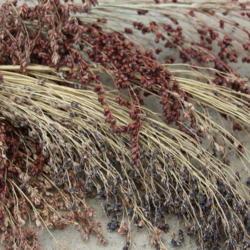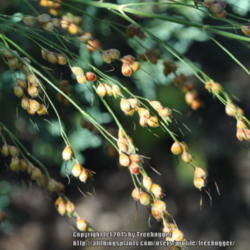Sorghum is in the grass family and is closely related to corn. In fact, when it's young it is nearly impossible to differentiate it from corn. If anyone ever tells you they have volunteer corn in their garden, you can sound smart by guessing that it's sorghum.
When we first bought our East Texas farm, it had been used for raising cattle for several decades, and as far as I can tell, it had never been used to raise any kinds of crops. It was interesting to see, however, a few volunteer sorghum plants here and there. They looked like corn plants, but instead of tassels, they produced large clusters of corn-like seeds at the tops. Sturdy and stocky plants, they grew in extremely poor, dry and unimproved soil, and seemed to thrive. I started researching this plant and learned that it's absolutely awesome, and I want to share it with you today.
Sorghum is in the grass family and is closely related to corn. In fact, when it's young it is nearly impossible to differentiate it from corn. If anyone ever tells you they have volunteer corn in their garden, you can sound smart by guessing that it's sorghum.
As you know, corn is a demanding plant. It requires irrigation, and has insane fertilizer requirements. It needs lots and lots of nitrogen or it'll be stunted, and in heat and drought it fails. Sorghum, on the other hand, is one of the most drought-tolerant grains you can grow, and is currently being studied so that its drought-tolerant mysteries can be unlocked. It will grow in any soil and can thrive in the dryest, hottest, and most challenging conditions.
Have you ever dealt with
Johnsongrass? It's one of the worst invasive weeds in the world, and it is a Sorghum! Of course, we would never want to grow Johnsongrass on purpose, but it makes my point: Sorghum is a powerful and easy-to-grow plant. The species Sorghum bicolor is the improved species that is not invasive and, in fact, not even perennial except in the tropics.
As mentioned above, as you near harvest time, it produces bountiful seedheads where the tassels would be. These heads produce hundreds of corn-type seeds that taste good and can be used in many ways. Couscous is made from coarsely ground sorghum, and the seeds can be finely ground to make a flour that is used in numerous recipes. Many varieties are available that produce seeds that can be popped like popcorn.
Many people know that sorghum has a very high sugar content, and in fact for around 150 years it's been grown in the south as a sugarcane replacement. The leaves and stalks are squeezed and the juice boiled down into molasses. In Asia and parts of Africa, alcoholic beverages are brewed using sorghum juice. Even Anheuser-Busch has gotten on board, producing a "gluten-free beer" using sorghum instead of the other grain ingredients.
The plant is also fully edible to animals, and makes a fine hay or silage product for cattle, hogs and other animals. The grain heads can be harvested for the same purpose, and chickens especially love and perform well on a diet of sorghum grain heads.
The plant also shows promise for ethanol production, replacing corn, which is much more expensive and difficult to grow. Growing sorghum allows a farmer to produce food, feed and fuel. Currently, 12% of grain sorghum grown in the United States is used to produce ethanol.
The plant also produces a nice straw that can be made into a plywood type product that's useful in construction and can be woodworked like any plywood or particleboard. On top of all that, there are many cultivars that are highly ornamental, look great while growing in the garden, and in the fall can be harvested, dried and stacked for beautiful Thanksgiving porch decorations.
Where to get it? That's easy. Numerous vegetable seed catalogs offer sorghum.
VictorySeeds.com has a wide selection of what they call "decorative broom corn" as well as other sorghums for molasses production, popping and general grain use.
Baker Creek Heirloom Seeds also has a good selection, as do
Johnny's and
Fedco.
Growing sorghum is much like growing corn. A nicely prepared bed or field can receive the seeds directly sown once the soil is quite nice and all danger of frost is gone. For me, that means the walnut tree leaves are out and at least dime sized. You can also start the seeds indoors and transplant them outside when the conditions are favorable. It germinates quickly and should be kept weed free until the plants are large enough to handle themselves alone. Some additional nitrogen fertility would be helpful, but in my experience isn't necessary.
Once the seeds start to be produced, you'll notice they are similar to corn. You can squeeze the seeds and a milk will squeeze out. A couple of weeks after this phase, you can harvest for squeezing into juice, or leave it on and let the seeds ripen fully to be used as a grain. For decorative purposes, just leave them growing until they die in place, then harvest at ground level and tie into shocks.
Most sorghums are not hybrid, and you can easily save the seeds for next year, and for sharing with other gardeners. An excellent variety that I recommend is 'Texas Black Amber Molasses', available from Victory Seed Company. It grows up to 12 feet tall, has beautiful shiny amber-colored seeds, and can be used for silage, molasses, and grain. If you like popcorn, try growing 'White Popping Sorghum' which produces tiny poppable seeds that have a nutty flavor. There are hundreds of varieties, so do your own research and try some out. Save and share seeds from your favorites, and enjoy this wonderful plant that is so well suited to our southern climate.
To see all our sorghums, check out our
Plants Database.

